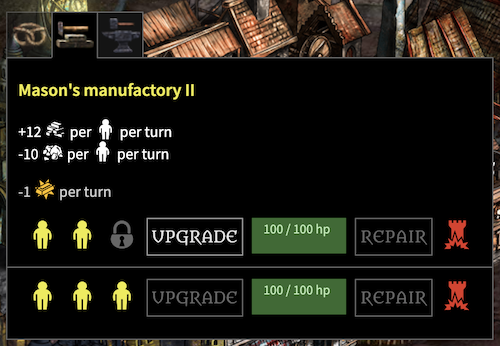Hello everyone, welcome back to our regular diaries. We will keep exploring the game’s mechanics and today’s focus will be on buildings.
Hello everyone, welcome back to our regular diaries. We will keep exploring the game’s mechanics and today’s focus will be on buildings.
Buildings are closely tied to tiles, which we explained last time, but just to refresh and better put buildings in some context. You can cultivate your land into three types of tiles – industrial, village and city. Each tile is associated with specific buildings. Generally speaking, you can construct buildings that extract primary resources, for example an iron mine, only on industrial tiles. In villages you can construct workshops that process these primary resources into secondary resources that you can actually use in your economy and also basic civil buildings, like school or water tower. In cities you can construct the most advanced (and most expensive) buildings, that often open new gameplay options or seriously improve your governorate.
Industrial buildings occupy the entire industrial tile, village and city tiles buildings occupy one slot from the tile. Each village and city tile can be upgraded to provide space for up to six buildings.
Some buildings are concentrated in chains, meaning that players start at the bottom with a basic version of that building and can build up to the most advanced versions unlocking new and stronger effects along the way. You can, for example, build your basic marketplace but with enough investments it can be upgraded to a mighty trading hub which will obviously make you more money.
All buildings share some common traits, they have hit points, construction costs given in resources, turns to build and maintenance. In order to construct a building, you need to have the amount of resources required, after that, it will take a set amount of turns to finish the construction. When it’s done, the building will require maintenance and drain some of your gold every turn, if you can’t afford the maintenance, your population will start to lose happiness. Buildings lose hit points by hostile actions like sabotage, spells or attacks.
Buildings under 100% hit points don’t provide their effect and must be repaired. Repair cost depends on the damage done and the type of building and the entire repairs can take various amount of turns.
Players also can demolish buildings by themselves to free up space or to change their strategy.
More buildings can be constructed, upgraded or repaired at the same time, provided the player has the resources for it.
And that’s it for today, see you again next time.







